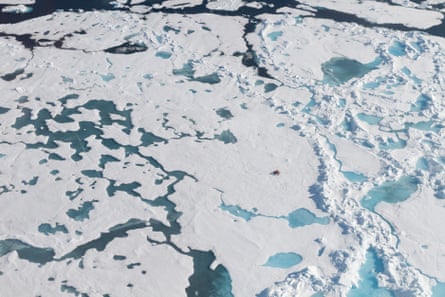Abundant levels of microplastic pollution have been found in snow from the Arctic to the Alps, according to a study that has prompted scientists to warn of significant contamination of the atmosphere and demand urgent research into the potential health impacts on people.
Snow captures particles from the air as it falls and samples from ice floes on the ocean between Greenland and Svalbard contained an average of 1,760 microplastic particles per litre, the research found. Even more – 24,600 per litre on average – were found at European locations. The work shows transport by winds is a key factor in microplastics contamination across the globe.
The scientists called for research on the effect of airborne microplastics on human health, pointing to an earlier study that found the particles in cancerous human lung tissue. In June, another study showed people eat at least 50,000 microplastic particles per year.
Many millions of tonnes of plastic are discarded into the environment every year and are broken down into small particles and fibres that do not biodegrade. These particles, known as microplastics, have now been found everywhere from high mountains to deep oceans and can carry toxic chemicals and harmful microbes.
The latest study was led by Dr Melanie Bergmann of the Alfred Wegener Institute for Polar and Marine Research in Germany. She said: “We really need research on the human health aspect. There are so many studies being published now on microplastics but nothing on human health, and that is really strange in my opinion.” Bergmann added that microplastics should be included in air pollutant monitoring schemes.
Bergmann had previously found 12,000 microplastic particles per litre in samples of Arctic sea ice: “So we asked where does it all come from?” Some is carried from populated regions by ocean currents, but analysis of snow samples shows much is blown by the wind.
“Microplastic concentrations in snow were very high, indicating significant contamination of the atmosphere,” concluded the study published in the journal Science Advances.
“It basically gets everywhere with the wind,” said Bergmann. Pollen and dust from the Sahara are already known to be blown over long distances. As well as the Arctic ice floes, the team’s 22 samples included snow from Svalbard, an island well north of the Arctic circle, the German and Swiss Alps and the city of Bremen.
The team found that the smallest particles were the most abundant, but their equipment could not detect particles smaller than 11 microns.
“I am convinced there are many more particles in the smaller size range beyond our detection limit,” said Bergmann. “The worry with smaller particles is they can be taken up by a greater range of organisms and, if they reach nano-scale, they could penetrate cell membranes and translocate into organs much more easily than the larger fraction.”

Microplastics from polymer-based protective coatings on vehicles, buildings and ships were the most common of those frequently found by the researchers, followed by rubber, polyethylene and polyamides including nylon.
The researchers cite a 1998 study as the only assessment of microplastic in human lungs. It found inhaled fibres were present in cancerous lung specimens and concluded: “These bioresistant and biopersistent plastic fibres are candidate agents contributing to the risk of lung cancer.”
The European commission’s chief scientific advisers said in a report in April: “The evidence [on the environmental and health risks of microplastics] provides grounds for genuine concern and for precaution to be exercised.”
Scientists not involved in the latest study expressed concern that supposedly pristine ecosystems such as the Arctic were contaminated.
“The work is very important because it strengthens the argument for much more stringent regulations on the plastics industry and forcing the governments of the world to address the issue of plastic pollution,” said Steve Allen, at the EcoLab research institute in France. “With [microplastics] pouring into our environment, it is highly likely we will only find out the safe levels after we have exceeded them.”
An earlier study published by Allen in April found significant microplastic quantities falling from the air in the Pyrenees, also implicating wind as a transport mechanism. The Bergmann-led research, however, is the first to look the contamination of snow.
Just two previous studies have looked at the presence of microplastics in the air, one in Paris, France, and another in Dongguan, China. Both found a steady fall of particles. Other recent research has found microplastics raining down on the Rockies in North America and in farmland soils near Shanghai in China.
